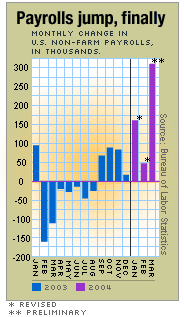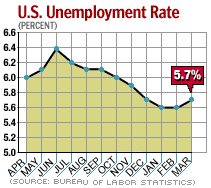NEW YORK (CNN/Money) - U.S. payrolls grew at the fastest pace in nearly four years in March, the government said Friday, in a report that soared past Wall Street forecasts and could play a pivotal role in Fed policy and the presidential election.
Though economists cautioned that one month does not a trend make, it was possibly the best economic news since the onset of the last recession in 2001, and a sign of spring for the nation's labor market, which has been mired in its longest slump since 1939.
Payrolls outside the farm sector grew by 308,000 jobs in March, the Labor Department said, compared with a revised gain of 46,000 in February. The unemployment rate, which is generated by a separate survey, rose to 5.7 from 5.6 percent.
Economists, on average, had expected 123,000 new jobs and unemployment at 5.6 percent, according to Briefing.com.
It was the strongest gain in payrolls since a matching gain of 308,000 in April 2000.

"We've been waiting for something like this for a long time," said Joshua Feinman, chief economist at Deutsche Bank Asset Management. "But we need to resist the temptation to put too much weight on any one month's report -- probably the best thing to do is to average out the past few months; that gives a clearer picture."
Payrolls grew an average 171,000 jobs a month in the first quarter, helped by upward revisions to January and February, versus average gains of 60,000 a month in last year's fourth quarter.
While it would seem odd that the unemployment rate rose despite strong job growth, the two numbers are generated by separate surveys. The unemployment rate comes from a survey of households, which found that 179,000 people entered the labor force in March without a matching rise in employment, resulting in a higher unemployment rate.
Still, most economists believe the survey of businesses, which is much broader, is a more accurate measure of the health of the nation's labor market.
Political, Fed implications
The surprisingly strong number should ease some of the political pressure on President Bush, who has been sharply criticized by Democrats for the loss of nearly 2 million jobs in the United States since he took office.
| 
| |

| 
| 
|

|
 Labor Secretary Elaine Chao comments on the latest jobs report and the health of nation's job market. Labor Secretary Elaine Chao comments on the latest jobs report and the health of nation's job market.
|
 Play video
Play video
(Real or Windows Media)
|
 CNN's Louise Schiavone reports on March jobs report: gain of 308,000 jobs, unemployment rate up to 5.7 percent. CNN's Louise Schiavone reports on March jobs report: gain of 308,000 jobs, unemployment rate up to 5.7 percent.
|
 Play video
Play video
(Real or Windows Media)
|
| 
|

|
|
But Democrats noted that nearly 24 percent of jobless workers have been unemployed for 27 weeks or more -- a 20-year high -- a sign, they say, that the labor market still has a ways to go.
"After three years of punishing job losses, the one- month job creation announced today is welcome news for America's workers. I hope it continues," Sen. John Kerry, D-Mass., Bush's likely opponent in November, said in a statement. "But for too many families, living through the worst job recovery since the Great Depression has been, and continues to be, far too painful."
The report also raised speculation that the Federal Reserve is closer than ever to raising its target for the fed funds rate, an overnight bank lending rate it manipulates to steer the economy.
Despite some signs of incipient inflation, most economists believe the Fed is waiting for a string of strong payroll reports before raising rates, and Friday's report could be the first in that string.
"If this report is supported over the next few months, then a summer increase in the funds rate is very possible," said Joel Naroff, president of Naroff Economic Advisors.
Stock, bond implications
On Wall Street, stocks rallied as investors bet the pickup in the job market would help economic growth, and thus corporate earnings, justifying higher stock prices -- though that could change if traders start worrying more about rising interest rates.
| Related stories
|

|
|
|
|
But prices tumbled in the bond market, where investors are more sensitive to changes in rates, pushing the yield on the 10-year Treasury up to 4.12 percent from 3.88 percent late Thursday. Bond prices and yields move in opposite directions.
"The sell-off in bonds is for real and is the correct reaction," said former Fed economist Robert Brusca, now chief economist at Fact and Opinion Economics, a private analysis firm. "The Fed will need confirmation to act. The bond market won't. It takes no prisoners."
Though employment often lags behind the rest of the economy, it has been slower than usual to recover from the 2001 recession, despite several quarters of economic growth, as firms have focused on cost-cutting, using technology to replace workers and sending some jobs overseas. That seemed to change in March, as 61 percent of all firms added jobs, the highest level since July 2000.
In its report, the department said service industries such as education and health care added 230,000 jobs in March. Goods-producing industries added 78,000 jobs, including 71,000 new construction jobs, helped by dry and mild weather across much of the country.
Some softness in details
Manufacturing payrolls were unchanged, after 43 months of declines. Economists had hoped this would finally be the month factory jobs would grow, based on recent surveys showing a greater inclination to hire.
Average hourly wages rose 2 cents to $15.54, but average weekly earnings slipped 88 cents to $523.70. Hourly wages have grown just 1.8 percent in the past year, near the lowest level since 1986.

The average workweek edged lower to 33.7 hours while the manufacturing workweek also dipped, and temporary help payrolls, another leading indicator of where the job market is headed, fell for only the second time in the past 11 months.
While these signs of weakness are clues that job growth of 300,000 per month won't be sustained, many economists still believe the job market is improving.
"Everything is falling into place, with the way our cyclical indicators are behaving," said Lakshman Achuthan, managing director of the Economic Cycle Research Institute (ECRI), a research firm that generates leading indicators of inflation and economic growth. "We should see the direction of job growth continue to improve."
Implications for economic growth
The strong job number could also boost consumer confidence -- good news, since consumer spending fuels two-thirds of the economy.
But consumers have been skeptical about job growth, and may continue to feel that way until it becomes clear whether March's pace of job growth can continue.
Businesses, meanwhile, will probably continue to focus on keeping costs low, especially in manufacturing. For example, orders for long-lasting business equipment have slowed in recent months, according to Commerce Department data.
"This report does not signal an acceleration in GDP growth," said former Fed Governor Lyle Gramley, now a consulting economist with Schwab Washington Research. "There are so many other things going on, including terrorism abroad, that I see no big burst of confidence emerging from this."

|

